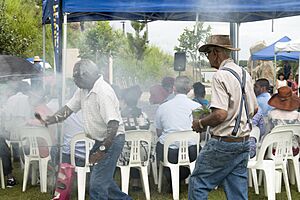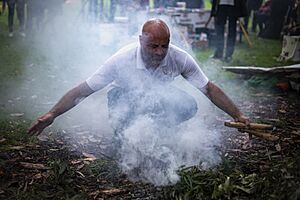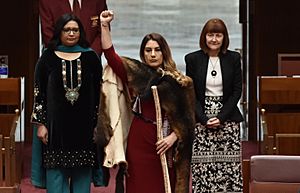Smoking ceremony facts for kids

A smoking ceremony is an old and still-used custom among some Aboriginal Australians. It involves burning native plants slowly to make smoke. People believe this smoke helps to clean things spiritually and physically. It is also thought to keep away bad spirits.
In traditional culture, smoking ceremonies happened after childbirth or special initiation rites. Today, parts of these ceremonies are often included in Welcome to Country events. They are also part of other spiritual gatherings open to everyone.
Scientists have found that smoke from Eremophila longifolia, also known as the Berrigan emu bush, can kill germs. This plant is often used in these ceremonies. This germ-fighting effect only happens when the leaves are heated. Smoking a newborn baby or a new mother is thought to help prevent infections.
Contents
What is the Cultural Meaning of Smoking Ceremonies?
Smoking ceremonies happen at important times in a person's life. The exact traditions depend on each Indigenous nation. Smoke can be made by lighting a fire of paperbark. Then, green leaves are placed on top to smoulder. The fire might be in a pit, in a special area, or even in a bucket.
Smoking Ceremonies for Birth
Smoking ceremonies can be done when a baby is born. This welcomes the new baby into the community. It also helps the mother and child stay healthy. This practice is seen as 'baby business' and is usually led by women in the community.
Each part of the ceremony has a special meaning. For example, in the Darug nation:
- Smoking the feet connects a person to their land.
- Smoking the chest links the heart, family, and land.
- Smoking the hands reminds people to take only what they need from the land.
- Smoking the mouth connects them to their Indigenous language.
Smoking Ceremonies for Initiation
Some Indigenous groups in Central Australia perform initiation rites for boys. These ceremonies welcome boys into adulthood. They mark the start of their involvement in men's community matters. Smoking ceremonies are part of these initiations. They help with spiritual and physical cleansing.
Smoking Ceremonies for Death
Smoking ceremonies are also held in a deceased person's space. This helps their spirit move on from the physical world. It also cleanses the location. This ceremony is very important. It might involve smoking a person's house, room, or car. This helps their spirit return to their traditional land.
Depending on the Indigenous Nation, branches might be swept across the area. This is said to weaken the link between the dead and living worlds. It may have replaced burning the clothes and belongings of the deceased. Community members might also paint ochre on places where the person lived. This helps the spirit move on and tells the community that someone has died.
If the ceremony is in an enclosed space, it changes a little. A small fire might be built inside the home. Or, a bucket of smoking coals might be brought into the house.
Gundungurra Smoking Ceremonies
The Gundungurra people live in an area that includes NSW’s Jenolan Caves. For them, smoking ceremonies, called Numbuk Yabbun, have been used to show when someone was leaving or entering their country. They also used them for spiritual cleansing.
Welcome to Country Ceremonies
Indigenous Australians have traditionally used smoke and fire to communicate. People would light a fire when entering another group's land. This signaled their arrival. It also acted as a call for help if needed.
Today, smoking ceremonies are often part of Welcome to Country events. These ceremonies are part of reconciliation efforts. They recognize the traditional owners of the land. They also involve Aboriginal Australians in events held on their land. Indigenous elders and community members perform these smoking ceremonies. They are open to the public, unlike older, private ceremonies. While not all Indigenous cultures use smoking ceremonies, many elders across Australia perform them.
Royal Welcome to Country Ceremony
In 2018, the Duke and Duchess of Sussex visited Australia. They took part in a smoking ceremony. This was for the unveiling of the Queens Commonwealth Canopy in K’Gari National Park. Butchulla elders performed the ceremony as a Welcome to Country. It highlighted the focus on Indigenous forests. This was the first smoking ceremony performed for royalty.
Other Events with Smoking Ceremonies
Beatification of Mary MacKillop
In 1995, Pope John Paul II honored the Australian nun Mary Mackillop in Sydney. Twenty-six Catholic Aboriginal Australians were present. Aboriginal Australians performed a smoking ceremony instead of burning traditional incense. The Pope specially mentioned the presence of Aboriginal Australians throughout Australia's history. Indigenous community members saw this as a positive step towards healing with the Catholic church.
Melbourne Midsumma Festival
In 2020, the Midsumma Festival invited Aboriginal elders. They performed a Welcome to Country ceremony before the march. This included a smoking ceremony. They honored the Faces of Aboriginal Pride. These were Stone Motherless Cold and Astro, chosen at the 2019 Victorian NAIDOC Pride Night.
Lidia Thorpe’s Induction into Parliament
When Senator Lidia Thorpe was elected to the Victorian Legislative Assembly in 2017, she wore a traditional fur cloth. This represented her ancestry as a Djab Wurrung Gunnai Gunditjmara woman. Her swearing-in included a smoking ceremony as part of a Welcome to Country.
Her later appointment to the federal senate in 2020 also included a smoking ceremony. This took place at the Aboriginal Tent Embassy. She carried a message stick. It had a mark for each Indigenous person who died in custody since 1990.
Biological Properties of Plants in Smoking Ceremonies
Plants used in smoking ceremonies have different natural properties. When smoked, these properties can help people. The chemicals in these plants mean the ceremonies are not just spiritual. They also have medicinal and physical benefits.
Emu Bush
Emu bush, also called Berrigan, is a traditional medicine. It is sacred to Aboriginal Australian cultures. Research shows that the amount and types of essential oils in these plants vary across NSW. These differences are linked to how the plant is used in ceremonies. For example, the Western Australian Emu Bush has some toxic compounds. So, Australian Sandalwood is more common there for ceremonies.
Heat affects how well helpful compounds in Emu Bush fight germs. Burning the plant also increases its physical benefits. The ceremony itself helps to get the most medicinal benefits. People in the ceremony are directly exposed to the smoke. The leaves are brought close to their skin and face. Sometimes, items are also singed with the leaves.
Australian Sandalwood
Like other Sandalwood types, Australian Sandalwood essential oils fight swelling and bacteria. While the oils can cause skin allergies in some people, smoking the leaves does not have the same risks. This is because less oil is absorbed, and its chemistry changes when burned.
Also, a study of 87 women showed that aromatherapy reduced anxiety. Sandalwood had the strongest effect. One compound in the oil may even protect against skin cancer. These strong physical properties greatly benefit Indigenous communities. This is especially true as smoking ceremonies expose both the skin and the lungs to the oils.




